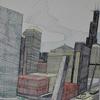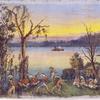Julie Green, Artist Known For Humanizing Death Row Inmates With 'Last Supper' Plates, Remembered
- October 24, 2021 19:50
Artist Julie Green passed away this month after a cancer diagnosis. “Green, a wide-ranging artist whose paintings also examined gender roles, wrongful conviction, animal abuse and their own colorful life — from a childhood in Japan to a teaching post in Oregon — was 60 when they died Oct. 12 at their home in Corvallis, Ore.," The Washington Post reported on Friday.
Also an art professor at Oregon State University, Green was especially known for creating “The Last Supper,” 1,000 white plates with cobalt blue artwork that depicted the last meal of U.S. prisoners headed to the death chamber. A current exhibition at Bellevue Arts Museum displays hundreds of these plates.
According to the museum website, Green, who lived in the Willamette Valley with husband and artist Clay Lohmann, spent "half of each year, usually winter months, [...] painting The Last Supper."
Green was a recipient of the Joan Mitchell Foundation Grant for Painters and Sculptors and the Hallie Ford Foundation Fellowship, and included in A World of Art published by Prentice Hall. Green had forty-two solo exhibitions in the U.S. and abroad at venues including The Armory Show in NYC, Upfor in Portland, The Block Museum at Northwestern University, Hunter Museum of American Art, and University of Liverpool Art Museum.
The artist wrote for "The Last Supper" exhibition in 2020:
"Growing up, I admired quilts and ceramics in our Iowa home, as well as the larger-than-life historical figures and 20’ American flag made with ears of colored corn in a neighbor’s yard. Appreciation for homemade and handmade led me to paint blue food. I once shared my family’s support of Nixon and capital punishment. Now I don’t.
Oklahoma has higher per capita executions than Texas. I taught there, and that is how I came to read final meal requests in the morning paper. The Last Supper illustrates the meal requests of U.S. death row inmates. Cobalt blue mineral paint is applied to second-hand ceramic plates, then kiln-fired to 1,400 degrees by technical advisors Toni Acock and Sandy Houtman.
[...] While looking for a permanent home for the project, unless capital punishment ends soon, I will continue until there are 1,000 plates. For me, a final meal request humanizes death row. Menus provide clues on region, race, and economic background. A family history becomes apparent when Indiana Department of Corrections adds, 'He told us he never had a birthday cake so we ordered a birthday cake for him.'
Art can be a meditation. Why do we have this tradition of final meals, I wondered, after seeing a 1999 request for six tacos, six glazed donuts, and a cherry Coke. Twenty-one years later, I still wonder."





















